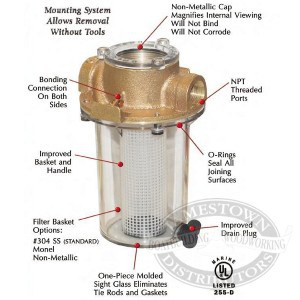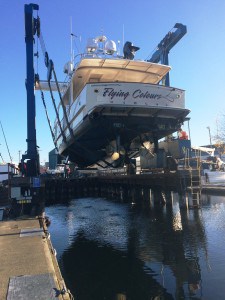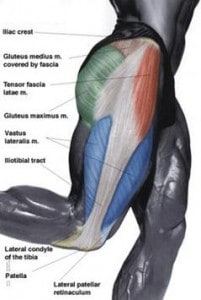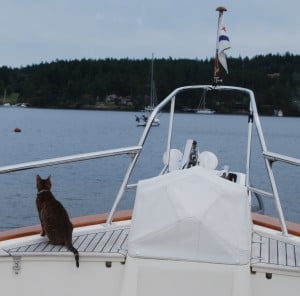Our 2017 cruising departure date was set for the beginning of May, and our hoped-for destination has been SE Alaska. Yup, so much for that plan. One equipment delay after another has plagued us, not to mention a nagging and painful knee tendon (called the IT band) that’s been inflamed.
Let me first explain the title of this post. We’ve moved onto the boat at our slip in Anacortes Marina – Kap and I, plus Jamie and ZuZu – getting as close as possible to wrapping up for a departure. But the wind is blowing like stink, wave heights in the San Juan Islands are 4’, it’s raining cats and dogs, and as much as we’d like to depart, we’re in no hurry when it’s this lousy. On the other hand, our slip is covered with a 20’ high corrugated metal roof, and while it’s dry, the roof and the solid 15’ tall wooden piling breakwater at our stern makes it dark and gloomy inside the boat, pushing us to depart. So, as I begin to write this post we’re technically “on the water, but haven’t actually left the dock. As I continue to write, though, we’ll be leaving and heading out for the summer.
With the weather clearing a bit and everything ready to go at mid-afternoon Thursday (June 13th), Kap is doing her “engine checks” before starting the engines. The plan is for a quick, 2-hour cruise to the Seattle Yacht Club outstation at Friday Harbor on San Juan Island – more as a shakedown cruise than anything else. If all goes well, we’ll then head across the Canadian border to Sidney to begin our summer’s cruise.
If you want to see where we are, or better yet, monitor our route progress, you can go to www.ronf-flyingcolours.com and click on the Current Location link in the upper right corner of the home page.
As my “getting underway” posts from previous years will attest, something always goes amiss just before our departure on major adventures, and this afternoon is no exception. Kap pops her head up from the cockpit hatchway and announces we have a problem with the starboard main engine sea strainer – the sight glass for it appears to be clogged with black gunk . . . similar to raw sewage that we apparently sucked into the port engine sea strainer a month earlier when we were moving the boat from the covered slip to work on the DirecTV installation (the satellite dish atop our boat has to be able to “see” the TV satellites during activation, and the roof on our slip blocks that, plus our antenna arch is folded down for clearance).
Before Kap can start cleaning the nasty gunk from sea strainer basket, she notices a fresh build-up of salt halfway around the sight glass flange where it attaches to the metal cap on the 4” water line that brings salt water in through a “thru-hull” in the bottom of the boat. After filtering out any junk that could clog the cooling waterways inside the engine, the water is then routed into the main engine. If there’s salt around the rim, that can only mean there’s a crack in the hardened plastic glass that surrounds the strainer – and that’s an even worse problem.
Our departure is definitely postponed – for two reasons: (1) if the sea strainer is clogged and water can’t get through, the engine will overheat and temperature sensors will immediately shut it down; or worse (2) if the sight glass catastrophically fails, sea water rushing in could overpower the bilge pumps, sinking the boat. Checking all sea strainers is one of the most important of the engine checks.
This particular sea strainer is in a tight spot at the forward end of the main engine, so it’s hard to get to. Kap begins the unenviable task of emptying the smelly gunk from the sea strainer basket – and concludes that whatever is in it is just rotting seaweed from the shallow bottom beneath our boat (on the earlier occurrence, Kap was certain it was human sewage that was sucked in, most likely from some idiot in the marina dumping their black water tank at their slip, rather than going to a pump-out station). After getting that all cleaned up, she began the task of removing the sight glass – which proved easier said than done. Of the six bolts holding the sight glass in place, four are fairly easy to remove. Two, though, are very difficult to access and heavily crusted in salt they are a bugger to loosen. The job continues into Friday morning.
When work resumes, both of us are fixated on the last two bolts and they are finally removed. Sure enough, each of the six bolt holes have large cracks emanating from both sides of the holes, plus the sight glass itself is cracked, and that’s what caused the leak. From a printed diagram of the sea strainer that we have on board, we figure out the part numbers for every piece of the sight glass. I drove to the marine parts department at Cap Sante Marine Service in town – but no luck . . . they can get a replacement to us on Monday afternoon, but that would delay our departure until at least Tuesday. I check West Marine on the off-chance they might have one, but no-go. Finally, we call our regular marine yard in Seattle and they pick one up. I jumped in the car to meet their technician halfway on his delivery trip. I get back to Flying Colours at 2PM, and the new sight glass is replaced in good time – but it’s too late in the day to depart.
Don’t forget – any photo in this post can be enlarged simply by clicking on it.
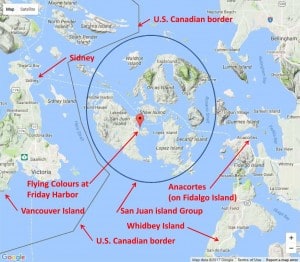
My SPOT device tracks where we are - and where we've been - in the last seven days. Our current location at the time I captured this Google Map is Friday Harbor (on San Juan Island), is shown by the red map pin in the center.
Saturday morning, after the last few details were buttoned up, we got away from our slip at 11AM and are (finally!!!) off for the summer’s cruise. Along the way, the sea strainer is checked several times to make certain it’s not failing. But sure enough, Kap notices there is now leakage from the port main engine sea strainer, indicating it too has failed for some damned reason. As soon as we arrive in Friday Harbor, I got on the phone to a local marine service center in town, and they are having a sight glass and O-rings air freighted up on Monday. When it arrives, it’ll be another difficult chore to replace the second failed sea strainer sight glass in a week.
(It’s interesting that in 2014 we received a Service Bulletin on these very same sea strainers from Fleming, for “cracking around flange securing bolts on the . . . [sea] strainer bowl”, and were cautioned that the failures were typically due to over-tightening the bolts. At that time, we had our alternate service yard in Sidney, B.C. replace both main engine sea strainers. And my guess is, for those to have now failed just three short cruising seasons later indicates that, in putting the new ones on the bolts were over-tightened, causing cracks around every bolt hole. But then, my mood right now is rather conspiratorial – the odds also favor simple engine vibration as the culprit. )
But before I go any further (and trying to keep my blood pressure low while writing this), there are some parts of the overall story from last fall/winter that need to be explained.
Cruise to Seattle for Flying Colours’ Annual Maintenance. In early November (2016) we had a break in the weather and brought Flying Colours south from Anacortes to the Ship Canal for regular annual maintenance. At our slip, everything seemed fine on initial engine start-up, but once out of the marina and heading south through the Swinomish Channel to La Conner, when we pushed the RPMs up to get our cruising speed, a serious vibration could be felt. It was obviously somewhere in the engine or drive train (driveshafts or propellers). A thorough check of the engine room found no evidence of a problem from the engines themselves, or in the driveshaft at the back of each engine. We figured it must be something on one or both propellers – maybe the snagging of a heavy algae bloom underneath the boat in our slip, caused by the weird fall weather we’d had. That had happened two years earlier, so we suspected it again. We tried shaking it off by running the engines in reverse, we tried changing RPMs, but nothing made it go away. After this fiddling around we were far enough away from Anacortes, plus we don’t trust any of the marine technicians there, so we figured we’d take it easy – reduce speed to 8 knots and see if we could find a sweet spot where the vibration was less – and hopefully limp down to Seattle. Our fear was that we’d do unfixable or very expensive damage to the boat, engine, or drive train.
After a rather nerve wracking day, we arrived at Shilshole Marine outside the Ballard Locks at late afternoon and moored there for the night. Next morning we continued on through the locks and tied up at Pacific Yacht Management just inside the Ship Canal from the locks. Chris Luckerath, our annual maintenance project manager at PYM, arranged for a haul-out at Seaview Boatyard just across the Ship Canal. (In the photo at left – I don’t care how many times we do this, I have to get my camera out to record a haul-out – watching something that weighs 30-tons – 65,000 lbs – lifted out of the water by three webbed straps. This is almost equal to the empty weight of the original 737-100 aircraft!)
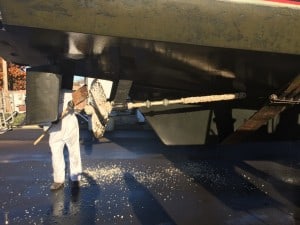
Almost every square inch of both propellors and the driveshafts were covered in white barnacles. No wonder we had such vibration during the cruise down from Anacortes.
Once clear of the water, our problem was obvious – an incredible crusting of barnacles on both props and driveshafts. We were amazed at this, as we’d just had a diver check the underside of Flying Colours in our slip about three months before, and he reported that the bottom was clean. (We plan not to use that diver in future.)
As we stood there with our jaws almost touching the ground, a Seaview technician used a shovel to scrape barnacles from the prop blades. Yes, those props in the photo at left are supposed to be brass-colored, not white.
As soon as Flying Colours was secure on the hard stand, the propellers were removed and sent out to a marine specialty shop, Kruger & Sons, to have them cleaned up, re-balanced to high specification, and “painted” with a special anti-barnacle varnish (Cost: $1,200). When re-installed, they looked like brand new.
The haul-out at Seaview also convinced us that other below-waterline work was necessary (which we hadn’t budgeted for), including all new bottom paint, clean up of barnacles around several of the thru-hulls and side thrusters. The list went on and on – costing us $10,500 for that unexpected work. (This gives new meaning to the definition of “boat” – break out another thousand.)
When Flying Colours was put back in the water a week after the haul-out, Kap and I jumped on board as she settled into the water and Kap started up the engines for our short trip across the channel to Pacific Yacht Management for the rest of our work. With higher-than-expected broadside winds, the Seaview crew had their hands full keeping us from being pushed sideways into the dock. Kap was working both bow and stern thrusters as hard as she could to keep us away, but it seemed the wind was hell-bent on slamming us onto the dock – and we risked a bunch of damage at the waterline. It didn’t take Kap long, though, to figure out that the bow and stern thrusters were operating backwards – she’d push to starboard on the joy sticks and the boat moved to port – and that’s what was really causing the mayhem. Once she got that figured out, she could safely get us off the dock and out into the channel. Chris was waiting on the dock at PYM for us, and he promised to get the problem fixed. It was obvious the guys at Seaview had re-installed the thruster blades backwards during the barnacle removal and cleanup. Nothing like an event like this to keep us on our toes! A couple of days later Flying Colours made the trip across to Seaview for a second, very short haul-out, where the thruster propellers were re-installed the proper way – at Seaview’s expense.
Throughout December the remainder of the annual maintenance was finished up – oil change in both main engines and our big generator, plus several repair items with our on-board cameras and dashboard equipment, plus a bunch of work on our “entertainment system” to ensure it would work with DirecTV when we convert over from DISH before next summer’s cruise.
But the main effort Kap and I were involved in with the boat was repeated days (and days . . . and days) spent at the boatyard trying to get the WhisperGen in good running order. It was either do this, or spend upwards of $25,000 to finally swap out this wonderful – but troublesome – system on the boat. To really explain this situation, I need to go back a bit more – and convolute this story even more.
I’ll say from the outset – the WhisperGen is an amazing high tech diesel engine. We installed it during the original commissioning of Flying Colours in 2009, and the primary goal was to keep our house bank batteries charged up when we’re at anchor (or, anytime we’re not on shore power). It was touted as being: (a) whisper quiet, unlike the big generator that we have for the heavy duty tasks, such as heating water, making water, running the electric cooktop, raising and lowering the dinghy with the davit, etc; (b) automatic, in terms of sensing the charge state of the house battery bank, and starting up, running, and shutting down when it determines a charge of the house bank batteries is necessary; and (c) we had hoped it would be maintenance and trouble-free due to the very minimal number of moving parts that a Stirling diesel engine has compared to a regular diesel engine.
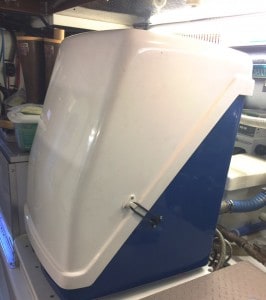
This sleek futuristic fiberglass cover of the WhisperGen hardly looks like it should be in a boat engine room. But then . . . this is a very clean engine room.
For about four years, our WhisperGen did all of those things exactly as planned. But then we discovered that it required more maintenance and TLC than we’d been giving it – and we’ve since paid the price. Because it was a new and exotic piece of gear – and we had little idea how it actually worked – it turns out our annual maintenance yard(s) weren’t technically qualified to service it either.
Our other big problem we faced with the WhisperGen is the result of a tragic incident that occurred not long after we bought it. A tiny company in Christchurch (New Zealand), called WhisperTech, engineered and manufactured the WhisperGen in the early 1990s. We bought our unit in 2009, shortly before a major earthquake struck the South Island of New Zealand (2011) – and the epicenter was close to the City Center of Christchurch where WhisperTech was located. The quake almost decimated the city. A week later, the WhisperTech building was pulled down due to very heavy structural damage. As a result of being undercapitalized in the first place, coupled with the lack of financial backing to rebuild the company, WhisperTech went out of business – and with it, not only the shutting down of any new WhisperGen sales, but also technical support to keep the ones running that were in service. Claiming he could no longer get spare parts, our primary WhisperGen service tech on Vancouver Island (B.C.) suggested he could replace it with a “proper” generator – for only $25,000, as if that kind of money was just a drop in the bucket for us.
Then early last fall, as we were working on travel plans to Australia for Kap’s run in the Sydney Harbour Bridge Half Marathon (September 18th), we learned that an engineer from the now-closed WhisperTech was running an online store of spare parts for the WhisperGen, plus writing technical bulletins for performing maintenance tasks on units in service. I contacted the guy to see if he would be willing to give us an abbreviated technician’s maintenance course on it if we visited him in Christchurch. We struck a deal for a full day’s training, and we altered our travel plans, allowing us to swing by Christchurch after Kap’s Half Marathon. On September 24th, we showed up on the doorstep of a Dutch transplant to NZ, name of Jan (pronounced as “yawn” – and we never knew his last name). Real nice guy, very businesslike, reserved, and he definitely knows everything there is to know about the WhisperGen.
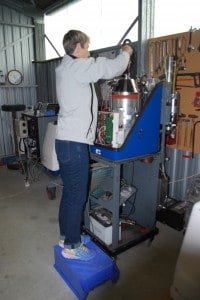
Kap and I spent a full day tearing down a WhisperGen on the test bench in Christchurch, NZ. Compared to a reciprocal engine (either gas or diesel), it has surprisingly few moving parts.
The photo at left shows Kap beginning a full “teardown” of a bench test model of the WhisperGen – a surprisingly uncomplicated diesel “engine” with very few moving parts, but remarkably finicky to keep properly tuned. In our day-long hands-on training session, we performed all of the standard maintenance functions, plus learned how to swap out failing parts that are most likely to have issues. We left the session feeling confident that we could now tackle the necessary maintenance on our own unit.
Our opportunity came shortly after arriving home, while Flying Colours was still at Pacific Yacht Management in Seattle’s Ship Canal. Over a period of several weeks, we spent every available hour running a full maintenance schedule on it, and replaced every part that we thought could be troublesome.
With high hopes, we fired up the WhisperGen . . . but it wouldn’t run. We corresponded by e-mail several times with Jan, adjusting this setting and that setting, and finally in January we had it running – and seemingly running reliably. With that, we were now comfortable with moving the boat back to Anacortes. At the first weather clearing – January 5th – we cruised back to Anacortes and got the boat safely moored at our home slip in Anacortes Marina.
Now I’ll explain Kap’s IT band problem that’s kept us at home. This is a long, thick tendon that starts at the hip, runs past the knee cap, and attaches to the tibia at the lower leg. It’s officially known as the iliotibial band, and the inflammation problem is typically due to friction as the IT bank slides against the outer part of the knee. It’s commonly known as “runner’s knee”, and for Kap it was caused by her running shoes that didn’t compensate for sloping surfaces that she was running on (as you know, streets slop to the outside for drainage, causing the knee and hips to roll inwards). After the problem developed earlier this year, Kap had it under control with special running shoes that were designed for this, but three weeks ago she attended a sports medicine clinic to test out some orthotics that would take care of it in regular shoes. But in just a few minutes with the orthotics she must have really “torched” her IT band (the words of her orthopedic surgeon), and in certain movements of the knee the pain was absolutely excruciating. The recovery is to stop irritating the IT band (duh!), so she’s been really taking it easy for almost all of May, and trying not to bend the knee in ways that inflame it.
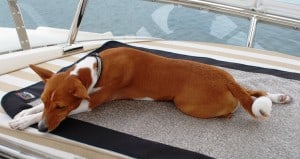
Once we left the dock, it took Jamie all of five minutes to get accustomed to being a boat dog. She slept here for the entire cruise over to Friday Harbor.
Departing Anacortes for Friday Harbor, Saturday, 11AM, June 17.
So, with all of those problems finally behind us, we were ready to depart Anacortes. We didn’t do anything stupid or foolish (one of my usual tasks), like leave the shore power cord plugged in (which we’ve done a couple of times, but not recently), and we actually got away from our home slip.
Our last stop was for fuel at Cap Sante Marina, next door to our marina – 349 gallons of diesel, at $2.16/gal, for a total cost of $819.11. It may not sound like it, but that’s a Little Gulper, considering that it often costs upwards of $2,500 if our four tanks that total 1,000 gallons are really low.
Since it was our first time away from the dock this year with Flying Colours, and since we’ve had various system problems for the past couple of years, the beginning few days were slated to be our shakedown cruise – just over to Friday Harbor on San Juan Island, a short two hour cruise to the Seattle Yacht Club outstation.
The cruise over was pretty uneventful – exactly the way you want it. It didn’t take long for Jamie to get comfortable – in fact, within five minutes of rounding the last turn from Anacortes she was fast asleep on a cushion in the fly bridge.
Even ZuZu has behaved. One of our biggest headaches while cruising with her is a penchant for jumping ship – and so far she hasn’t made a move towards jumping onto the boat’s side rails and then onto the dock. Give her time and I’m sure she will, but for right now she hasn’t.
As of this morning (Tuesday, June 20th), the replacement sea strainer sight glass for the port main engine has arrived via Kenmore Air float plane from Seattle, and today’s task is to get it installed. In a perfect world this would take less than an hour, but given how tight and inaccessible everything is on a boat, it’ll be more 4 hours, plus several bruised and skinned knuckles.
But it’s all worth it, just to have some water under our bums.
Hopefully I’ll have more interesting cruising stories to write about next time.

